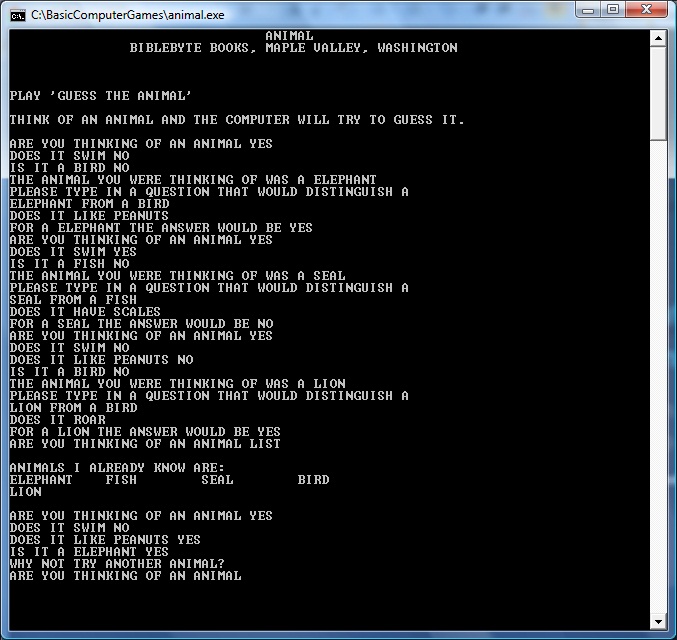Basic Computer Games - Small Basic Edition: Animal
Small Basic > Small Basic Books > Basic Computer Games Small Basic Edition** **> Animal
Unlike other computer games in which the computer picks a number or letter and you must guess what it is, in this game you think of an animal and the computer asks you questions and tries to guess the name of your animal. If the computer guesses incorrectly, it will ask you for a question that differentiates the animal it guessed from the one you were thinking of. In this way the computer "learns" new animals. Questions to differentiate new animals should be input without a question mark. This version of the game does not have a SAVE feature. If your system allows, you may modify the program to save array A, then reload the array when you want to play the game again. This way you can save what the computer learns over a series of games. At any time, if you reply "LIST" to the question "ARE YOU THINKING OF AN ANIMAL," the computer will tell you all the animals it knows so far. The program starts originally by knowing only FISH and BIRD. As you build up a file of animals you should use broad, general questions first and then narrow down to more specific ones with later animals. For example, if an elephant was to be your first animal, the computer would ask for a question to distinguish an elephant from a bird. Naturally there are hundreds of possibilities; however, if you plan to build a large file of animals a good question would be "IS IT A MAMMAL." This program can be easily modified to deal with categories of things other than animals by simply modifying the initial data in the A array and the dialogue references to animals in other program lines. In an educational environment, this would be a valuable program to teach the distinguishing characteristics of many classes of objects - rock formations, geography, marine life, cell structures, etc. |
This chapter is adapted from the book Basic Computer Games Small Basic Edition published by Kidware Software. To purchase this book in its entirety, please see the Computer Science For Kids web site. |
Originally developed by Arthur Luehrmann at Dartmouth College, Animal was subsequently shortened and modified by Nathan Teichholtz at DEC and Steve North at Creative Computing.
Code Listing (Small Basic File: animal.sb):
|
Sample Run:
Excerpt © Copyright 2010-2013 By Kidware Software LLC All Rights Reserved. Computer Science For Kids, the Computer Science For Kids logo, and related trade dress are trademarks or registered trademarks of Kidware Software LLC. Philip Conrod & Lou Tylee have co-authored dozens of books and tutorials for beginning Microsoft Basic, Small Basic, Visual Basic, and Visual C# developers of all ages for over 25 years.

